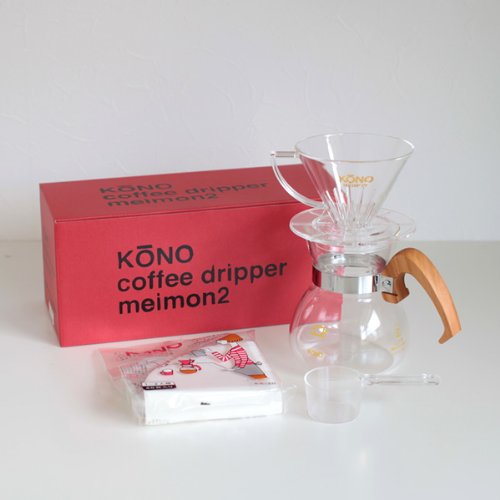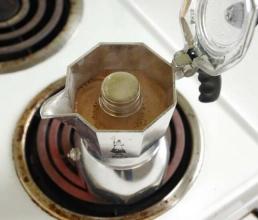The latest introduction of hand-made coffee filter cup the different types, functions and uses of coffee filter cup
We all know that the Vietnamese trickle filter cup was brought to Vietnam by the French at the beginning of last century, but I am afraid we don't know much about the history of who invented it. In fact, it is a replica of the earliest Melitte copper filter cup. If you compare the Vietnamese filter cup with the world's first copper filter cup invented by Mrs. Melita, you will find that they are almost the same in shape and structure except for their different materials. And the early Melitte porous filter cup is almost exactly the same as the current Vietnamese dripping pot. So, if you want to try what the early Melitte filter cup tastes like, you have to have a Vietnam drop cup. If you can tell the relationship and story of Melitte and Vietnam drip filter cup to the guests, it will certainly make the guests think highly of you.
The American follicle pot is a coffee pot invented in the United States by Dr. Peter J.Schlumbohm, who was born in Germany in 1941. Its design and particularity are recognized, not only selected as the "Illinois Institute of Technology" top 100 modern products, but also displayed by New York MoMa as a permanent collection of "Smithsonian and the Philadelphia Museum of Art".
The uniqueness of the American bubble pot is that the coffee pot and the filter cup are integrated, not separate. On the slender waist, the appearance wrapped in wood and leather rope is quite advanced and elegant. But the secret to extracting pure but flavored coffee lies elsewhere. The upper part of the filter cup of the American bubble pot has an air channel (air channel) in the shape of a funnel, which can supply air smoothly when extracting coffee, and the filter paper can be easily removed after use. There is also the filter paper used in the American bubble pot, which is about twice as heavy as the ordinary filter paper, but its advantage is that it can leak strong but non-bitter coffee.
The coffee extracted by the American filter pot can not only remove the excess oil and bitter ingredients, but also extract only the purest coffee. After frozen preservation, it still has its flavor even if it is heated and drunk again. When heating the bubble pot directly on the gas furnace, even if the heat-resistant glass is used, it is still dangerous, so it is better to put it on the iron frame or tripod and then heat it.
The filter paper of the American bubble pot is not funnel-shaped, but flat four corners or round filter paper. This is a common method in the laboratory. The flat filter paper is folded twice and folded into a funnel shape. Maybe it's because the inventor used to be a doctor of chemistry. The filter paper of Kono and Hario is also funnel-shaped with a sharp end. If the filter paper wall is soaked in water, it can withstand heavier coffee and use pressure to attach both sides. However, the funnel and flask part of the American bubble pot is not accepted, because of the filter paper, if you use the sewn filter paper, the two sides of the filter paper will break because of the weight of the coffee. It's as simple as putting filter paper on a mug and making coffee. But the basket-shaped filter paper can be folded twice like circular filter paper and folded into a funnel instead of being used.
Different shapes of grooves form different concave and convex exhaust channels, which will have different subtle effects on the taste of coffee, but this requires a deep understanding of the nature of coffee and hand-making utensils. Only experts who have accumulated considerable experience and attainments can experience it.
In addition to the above three most commonly used materials, there are heat-resistant glass, aluminum alloy, tin and other materials, and even in some hot countries in Southeast Asia, there are coffee filter cups woven with plants such as bamboo and flax, which is really pure natural and green.
In fact, as long as the coffee filter cup can meet the three basic conditions of filtration, ventilation and heat preservation, it can make good coffee. If we think about it, there are a lot of materials that can be replaced.

Important Notice :
前街咖啡 FrontStreet Coffee has moved to new addredd:
FrontStreet Coffee Address: 315,Donghua East Road,GuangZhou
Tel:020 38364473
- Prev

Coffee brewing utensils Kono brand introduction: KONO wooden handle coffee pot set group 2 people use cherry wood
Brand: KONO Color Classification: Cherry wood material: glass size: pot / bottom diameter 10 high 11.5cm (including handle width about 15.8cm) filter cup / diameter 9.7high 7.7cm (including handle width about 11.3cm) capacity: about 325ml material: handle / log, pot / heat-resistant glass, filter cup / acrylic resin can not be directly used in open fire combination content: coffee sharing pot, filter cup, measuring spoon, filter paper 40
- Next

Guide for the selection and purchase of mocha pot utensils the use and understanding of mocha pot utensils
I prefer mocha pot. I always think that mocha pot is beautiful and can be used as handicrafts. At the same time, it is easy to learn to brew coffee in mocha pot, easy to operate, and stable in quality, so it is the best tool for beginners to get started with coffee. However, it is also found that there are many misunderstandings in the understanding and use of the mocha pot, which leads to the bitterness of the coffee and the loss of confidence and patience to the mocha. I.
Related
- What is the Philharmonic pressure? How to use Philharmonic pressure to make delicious coffee
- Why does a hand grinder have more fine powder than an electric grinder?
- In addition to the hot mom, what is the difference between the versions of EK43 | ditting and Mahdi ek43?
- What kind of equipment do you need to make coffee by hand? Introduction to novice starter cooking equipment tools
- Espresso needs to be ground how thick and thin scale entry Italian Coffee Machine Bean Grinder investigation and Grinding course
- How much does it cost to open a small private cafe? How much does it cost to learn coffee? How to operate it?
- The difference between the flavor characteristics of hand-brewed coffee and coffee maker is hand-brewed coffee really better than coffee maker? Can I use a coffee machine to make coffee beans by hand?
- The difference between 01 and 02 of hario v60 filter cup what is the difference between 01 and 02 filter cup opening and cooking flavor
- What's the difference between the smart cup and the French kettle? Which is better, the French kettle or the Smart Cup?
- What's the difference between a smart cup and a V60 filter cup? The difference between the taste of smart cup and hand-brewed coffee

